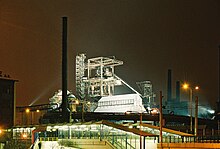Witkowitz iron works
Coordinates: 49 ° 49 ′ 12.9 ″ N , 18 ° 16 ′ 46.5 ″ E

The Witkowitz Iron Works ( Vítkovické železárny in Czech , VŽ) were one of the most important companies in Moravian heavy industry in the 19th and 20th centuries. Coal mining , coking , pig iron production , steel refining and processing as well as mechanical engineering were combined in a relatively small area . The systems still shape the townscape of Vítkovice today and are sometimes referred to as "Ostravské Hradčany" (based on the Prague Hradschin ). The blast furnaces and the coking plant have had the status of a national cultural monument of the Czech Republic since 2002 .
history
The Rudolfshütte ironworks in Witkowitz near Mährisch-Ostrau was founded in 1828 by the Olomouc Cardinal and Habsburg Archduke Rudolf Rainer at the suggestion of the Viennese professor Franz Xaver Riepl . After the bishop's death in 1831, Salomon Rothschild became interested in the company, which then used modern technology, but initially there was resistance from the cathedral chapter.
In the meantime, the plant has been expanded to include its own coking plant. The first blast furnace went into operation in 1836, and the second two years later. In 1839 a rolling mill was added. After a union was formed , which initially leased and expanded the smelter on a long-term basis, Rothschild succeeded in acquiring the plant in 1843. It was of particular interest to him because of the current construction of the Emperor Ferdinand's Northern Railway . In order to no longer have to rely on the delivery of coal, construction of a shaft began in 1852 and the coal was mined under the factory premises.
Around 1870 Anselm Salomon von Rothschild , Salomon's son, slowly withdrew from the industrial business. In 1873, the Witkowitz mining and smelter union was founded, in which the Rothschilds only held 51 percent, the Viennese coal wholesaler Wilhelm von Gutmann 49 percent. This participation situation remained intact until the expropriation in the course of the Aryanization under National Socialism . The works were incorporated into the Reichswerke Hermann Göring and produced v. a. Ammunition and later components for the rocket unit 4 (V2). On October 20, 1942, the expansion to Ostrava-Kunčice began. The " Nová huť " was later built on the site of the "southern building" erected there .
After 1945, the company was taken over by the Czechoslovak state and now operated as Vítkovické železárny Klementa Gottwalda np (VŽKG). The focus in Czechoslovakia at this time was on the construction and expansion of the steel works in Ostrava-Kunčice and Třinec , so that Witkowitz was not modernized with Soviet help until the early 1960s.
present
The historical development led to the fact that the original ironworks became a large industrial company, which was also dedicated to mechanical engineering. At the end of the 20th century, the company ran into great economic difficulties. The Czech government had to deviate from the original privatization plan and take over management of the company. The smelting and mechanical engineering parts of the company were separated and privatized separately.
As in other parts of Ostrava, coal mining ended in 1994.
Crude steel production was stopped and the last tapping took place on September 27, 1998 .
In 2002 the Dul Hlubina coal mine, the coking plant and the blast furnaces were declared a national cultural monument.
The mechanical engineering division has been operating under the name Vítkovice Holding since 2003.
Since 2005, the ironworks have belonged to the Russian steelworks and conveyor technology group Evraz Group under the name Evraz Vítkovice Steel . The company Škoda Vagonka as has settled on part of the area .
In 2008 part of the site and some buildings were declared European Cultural Heritage.
Part of the area is currently being converted into a culture and event center. In the summer months there are guided tours on the premises at the weekends.
swell
- Lecture by Milan Myška , XIV International Economic History Congress, Helsinki 2006, Session 70 (also available on the web)
- Věra Kučová, Miloš Matěj: Industrial Complexes in Ostrava. To be nominated for Inscription on the UNESCO World Heritage List. National Institute for the Protection and Conservation of Monuments and Sites - Central Unit Prague and Regional Department Ostrava, Prague 2007, ISBN 978-80-85034-02-8 .
Web links
- XIV International Economic History Congress, Session 41-80
- Vítkovice Holding Group
- Vítkovice steel, as
- Dolní oblast Vítkovice (Czech, including information about guided tours in the former steelworks and the redesign of the site)
- Pictures of the Witkowitz steelworks
- Extremely detailed company and product catalog from 1903
- Early documents and newspaper articles on Witkowitz ironworks in the 20th century press kit of the ZBW - Leibniz Information Center for Economics .
Individual evidence
- ↑ železárna - koksovna a vysoké pece Vítkovice se souborem technického vybavení ÚSKP 50336 / 8-4000 in the monument catalog pamatkovykatalog.cz (Czech).


